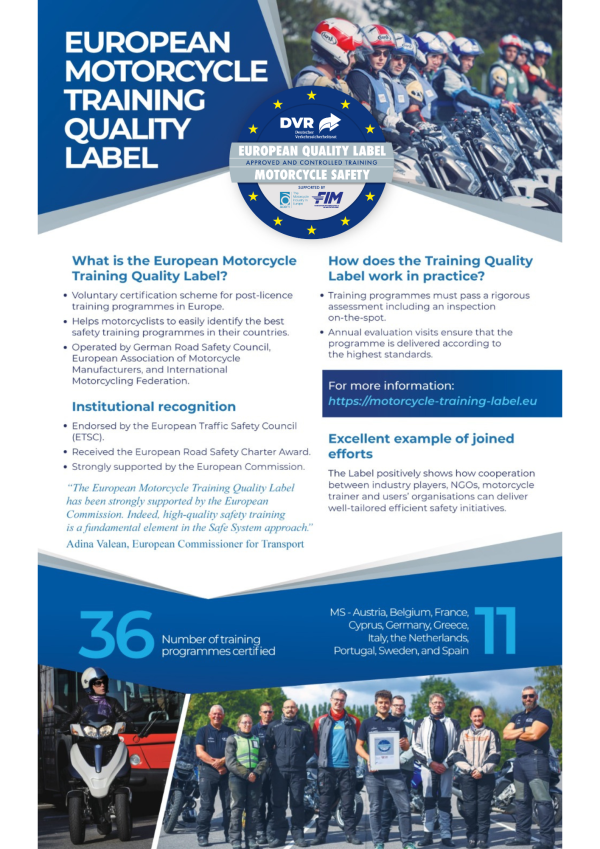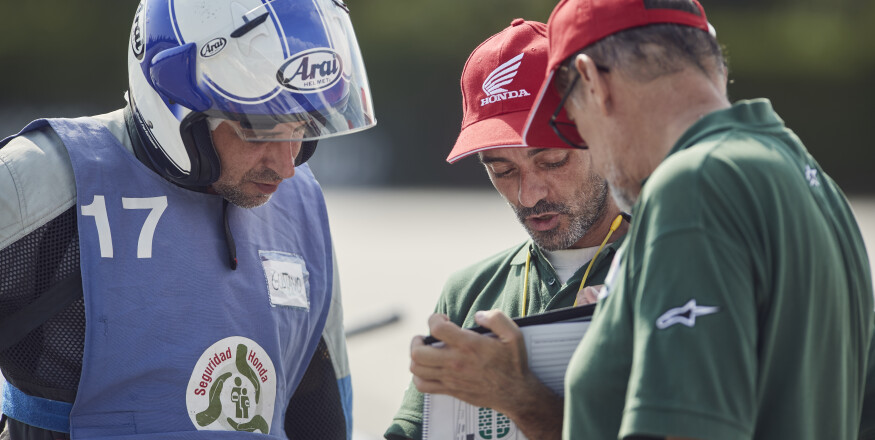Better training, safer riding
Better training, safer riding
The human factor is one of the most critical factors in accidents involving motorcycles. For this reason, the motorcycle industry is supporting life-long rider training for new and experienced motorcyclists, including pre-licence and voluntary post-licence training schemes.
Pre-licence training provides the basic skills and awareness needed for novice riders to use their vehicles safely on the road. Subsequently, advanced post-licence courses offer riders additional opportunities to increase their proficiency and safety as well as practice their hazard perception and risk awareness skills.
Post-licence training plays a key role in improving road safety, particularly for people who are upgrading to a more powerful motorbike, who are returning to riding after an extended period of time or for those who want to improve their riding skills and perception abilities. For many years, ACEM members have been offering high quality, tailored voluntary training options across the EU.
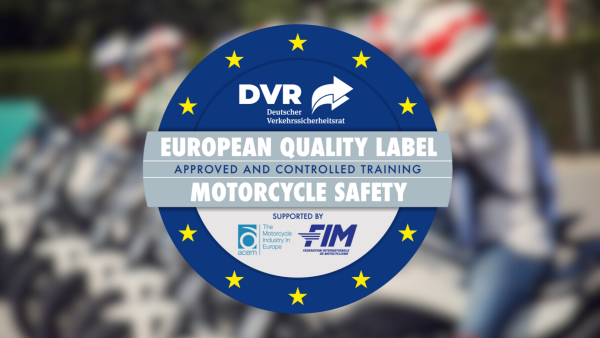
Launched in 2016, the European Motorcycle Training Quality Label has certified 36 motorcycle training programmes in Austria, Belgium, France, Cyprus, Germany, Greece, Italy, the Netherlands, Portugal, Spain and Sweden
The European Motorcycle Training Quality Label
Most of the training courses available across the EU, both at pre- and post-licence level, vary considerably across countries and schools due to different training requirements, specific vehicle use and the different levels of trainers qualifications, among other factors. Moreover, the quality of the thousands of different training schemes across the EU is heterogeneous and as there are so many options available, it is difficult for riders to identify the best ones and make informed decisions.
In order to address this information challenge, ACEM, the German Road Safety Council (DVR), and the International Motorcycling Federation (FIM) joined forces and launched the European Motorcycle Training Quality Label in 2016. The Label helps riders to clearly and easily identify high- quality post-licence training offers in their countries.
Visit the European Motorcycle Training Quality Label website to learn more.
Improving motorcyclists’ safety across Europe: Results
To date 36 training programmes operating in Austria, Belgium, France, Cyprus, Greece, Italy, Germany, the Netherlands, Portugal, Spain and Sweden have been certified. Riders are now well-informed about the best training offers in these countries.
The figures below show the impact of some of the labelled programmes on motorcycle training:
- The Swedish Association of Motorcyclists (SMC) trained more than 10,000 motorcyclists in 2023
- ADAC trained about 21,500 motorcycle riders in Germany in 2023
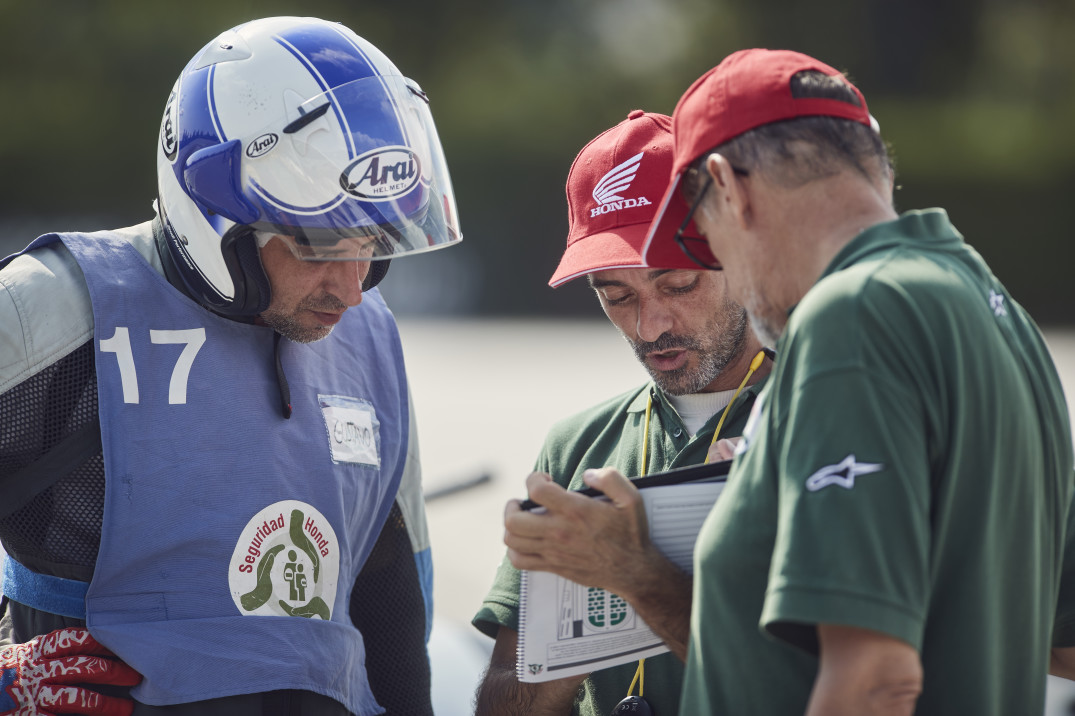
The advanced motorcycling course of the Honda Safety Institute in Barcelona received the European Motorcycle Training Quality Label in 2018.
Institutional stakeholders supporting the Label: Recognition at EU level
In 2018 the European Transport Safety Council, a prominent NGO in the field of road safety in Europe, acknowledged the importance of this initiative and joined the European Motorcycle Training Quality Label consortium as a supporter member.
In 2019, The European Commissioner for Transport, Violeta Bulc, released a video message that acknowledged the key role played by the European Motorcycle Training Quality Label in improving motorcyclists’ safety across Europe, saying: “We are grateful that the European Motorcycle Training Quality Label has been set up, responding to our call for voluntary commitments.”
The same year, the European Motorcycle Training Quality Label received the European Commission Road Safety Charter Award, in the category “voluntary commitments”. The award acknowledges inspirational and innovative initiatives that contribute towards improving road safety and saving lives on Europe’s roads.
“The European Motorcycle Training Quality Label has been strongly supported by the European Commission. Indeed, high-quality safety training is a fundamental element in the Safe System approach.” Adina Valean, former European Commissioner for Transport, 2020.
In 2024, the European Road Safety Charter highlighted the importance of the industry initiative at the event “Enhancing road safety for motorcyclists”.
The Label is an excellent example of how cooperation between industry, NGOs, motorcycle trainers and user organisations can deliver positive results in motorcycle safety. The European Motorcycle Training Quality Label also creates a strong incentive for training centres to distinguish themselves. It stimulates them to raise their quality standards, which will result in better safety training across Europe.
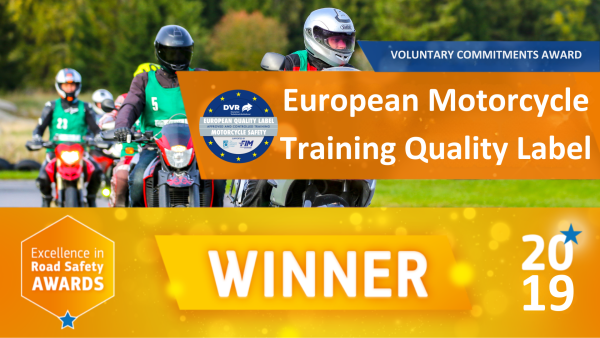
In October 2019 the European Motorcycle Training Quality Label received the Road Safety Charter Award
National and local authorities acknowledging the Label – good examples
- The Netherlands – local authorities in some regions are financing the safety training courses and the rider pays only 50€ to attend the certified training.
- Belgium – the Flemish government covers 45% of the cost of the certified training courses.
- Austria – the regional authority in upper Austria support financially the riders undergoing certified voluntary training with 75€.
Private companies endorsing the awarded programmes - incentives for riders
- Cyprus – thanks to the private company sponsorship 17- and 18-year-old riders go through the training free of charge. The other trainees pay only 20 € for undergoing certified safety training provided by the national motorcycle federation.
- Greece – the Insurance companies provide 25% discount to riders attending courses offered by the Hellenic Motorcycle Institute.
Paving the way to high quality standards for motorcycle training
In the medium and long-term the European Motorcycle Training Quality Label will increase the visibility of the best training programmes available, paving the way towards higher quality standards for training in Europe.
Industry ultimate goal is to increase the number of riders attending voluntary safety-oriented courses and thus improve riders’ safety performance in the European Union.
In 2023 all 36 schools awarded the European Motorcycle Training Quality Label and academia joined forces to prepare for a new high-quality training toolbox to address the most relevant and frequent powered-two wheelers accident scenarios.
The toolbox represents a natural evolution of the European Motorcycle Training Quality Label especially thanks to the united endeavors of training experts and academia, namely: Ludwig Maximilian University of Munich – LMU, Würzburg Institute for Traffic Sciences – WIVW, Institute for Motorcycle Safety – ifz, Traffic accident research at TU Dresden – VUFO and the Austrian Road Safety Council – KFV.
This tool will be offered free of charge to all training schools interested in improving the quality of their post-licence courses. To ensure a larger deployment, it will also be shared with bodies planning to set up voluntary motorcycle safety training programmes in countries with limited current training options.
